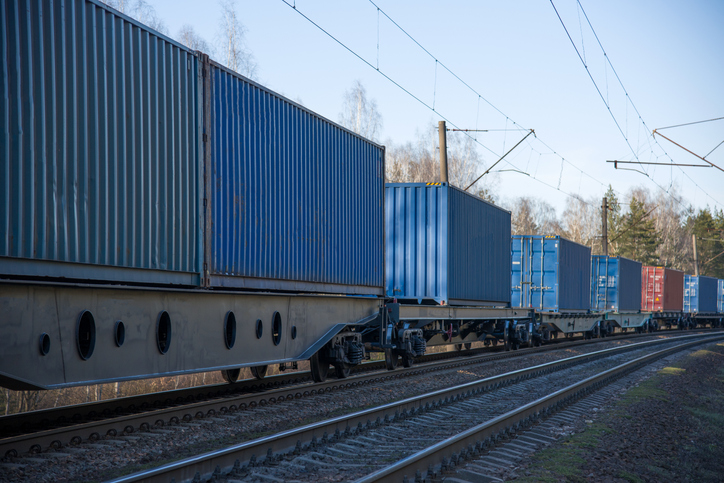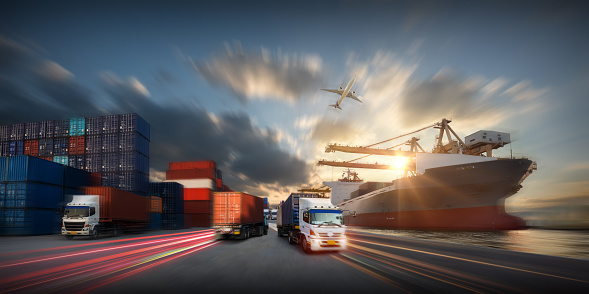Intermodal shipping is gaining momentum because it blends cost efficiency with sustainability. Union Pacific states that one railcar can carry three to four truckloads, implying a full train could carry the equivalent of 300+ trucks. This makes rail a powerful lever in reducing highway congestion and cutting per-mile shipping costs.
In this blog, we’ll explore how intermodal shipping works, its key benefits, and why it’s becoming a vital strategy for modern supply chains.
What is Intermodal Transportation?
Intermodal transportation, in its essence, represents a seamless and integrated approach to moving goods across various modes of transportation. It transcends traditional single-mode transportation by combining multiple modes, such as trucks, trains, and ships, into a coordinated system. This fusion of diverse transportation methods underpins the concept of multimodal logistics.
The Strengths of Intermodal Logistics
Intermodal logistics offers a multitude of advantages that cater to the modern shipping landscape. Let's delve into these strengths:
- Cost-Efficiency: Multimodal logistics excels in cost-efficiency, especially for long-distance shipping. By strategically integrating different modes, it optimizes the use of resources and reduces overall transportation expenses.
- Environmental Benefits: In an era of increasing environmental awareness, multimodal logistics shines as an eco-friendly choice. Its reliance on railways and waterways minimizes carbon emissions, contributing to sustainability objectives.
- Flexibility and Versatility: Multimodal logistics is known for its adaptability. It can seamlessly transition between various transport segments, accommodating a diverse range of cargo and destinations.
- Safety and Security: Securely sealed containers and streamlined processes enhance the safety and security of multimodal shipments. This reduces risks during transit, ensuring the safe arrival of goods.
Drayage: Bridging the Gaps
Crucial to multimodal logistics is the concept of drayage. Drayage refers to the short-distance movement of goods between transportation hubs, typically the "first mile" and "last mile" of the shipping journey. Drayage services act as the connective tissue, efficiently transferring containers from one mode of transportation to another. This seamless transition minimizes delays and ensures cargo flows smoothly through the supply chain.
The Role of Intermodal Marketing Companies (IMCs)
Intermodal Marketing Companies (IMCs) play a pivotal role in facilitating multimodal transport. They act as intermediaries, connecting shippers with transportation providers across different modes. IMCs leverage their expertise and network to optimize routes, select the most cost-effective carriers, and streamline the entire transportation process. Businesses benefit from IMCs' industry insights and logistical prowess.
Challenges in Intermodal Transportation
While integrated freight systems offer a plethora of benefits, they are not without their challenges. Businesses must be aware of potential obstacles to ensure a successful logistics strategy. Some of the common challenges include:
- Transition Delays: Intermodal shipments involve transitions between various modes, which can introduce delays if not executed seamlessly. Efficient coordination is essential to mitigate such issues.
- Infrastructure Considerations: The quality and availability of transportation infrastructure can impact the efficiency of multimodal transport. Businesses must assess infrastructure capabilities along their chosen routes.
- Weather and External Factors: Inclement weather or unforeseen external factors can disrupt intermodal shipments. Contingency plans and real-time monitoring help address these challenges
Even with the advantages of intermodal transportation, the success of your shipping strategy depends largely on the partner you choose to manage it.
Why Choosing the Right Logistics Partner Matters
Selecting the right logistics partner is crucial when implementing multimodal solutions. While multimodal transport integrates multiple modes, it requires expert coordination to avoid delays and inefficiencies. A strong partner provides:
- Network access: Leveraging trusted carriers and rail lines to optimize routes.
- Visibility: Real-time tracking and data integration to ensure transparency.
- Risk management: Experience in handling cross-border compliance, customs, and insurance requirements.
- Strategic planning: Advising when and where multimodal should be used for the greatest value.
The advantages of intermodal transportation are amplified when businesses work with a partner who understands the nuances of rail, drayage, and cross-border logistics. Without the right expertise, shippers may struggle with missed connections, capacity shortages, or underutilized resources. A skilled logistics partner ensures intermodal isn’t just an option — it becomes a competitive advantage.
While intermodal logistics offers multiple operational benefits, the real question for many businesses is why it should be part of their supply chain at all.
Why Should Shippers Use Intermodal in Their Supply Chains?
The advantages of intermodal transportation extend far beyond simple cost savings. Shippers use intermodal because it addresses four major logistics challenges: cost, capacity, sustainability, and reliability.
- Cost efficiency: With fuel-efficient rail and fewer trucks on the road, intermodal often lowers per-mile shipping costs.
- Capacity access: Rail networks provide additional lanes of capacity that can offset truckload shortages.
- Sustainability: Fewer trucks reduce both emissions and congestion, helping companies align with ESG initiatives.
- Reliability: Sealed containers and controlled transfers increase cargo security and reduce damage risks.
For companies managing cross-border shipments, the advantages of intermodal transportation become even more evident. It allows businesses to integrate rail for long hauls while using drayage for first- and last-mile moves, creating an adaptable, scalable system that keeps goods moving efficiently.
As businesses weigh cost and efficiency, sustainability remains a growing priority. One overlooked area where the advantages of intermodal transportation shine is noise reduction.
How Does Multimodal Transport Contribute to Reducing Noise Pollution?
One of the lesser-discussed advantages of intermodal transportation is its ability to reduce noise pollution. Trucks traveling long distances often create significant noise, especially in densely populated areas. By shifting large portions of freight to rail or waterways, businesses lower their dependency on road transport, which in turn reduces noise levels along major highways.
Rail transport, in particular, has stricter noise regulations and typically runs through designated corridors, minimizing disruptions to residential zones. This not only contributes to sustainability goals but also strengthens community relations by reducing the environmental footprint of logistics operations.
For shippers aiming to meet sustainability and compliance targets, highlighting the noise-reduction benefits adds another layer to the advantages of intermodal transportation.
Craft Your Logistics Plan with Visigistics
At Visigistics, we specialize in international and domestic logistics solutions that harness the power of multimodal transport. Our team of experts is dedicated to optimizing your supply chain, reducing costs, and enhancing sustainability through tailored intermodal logistics strategies. Get in touch with us to explore how integrated freight solutions can elevate your business's shipping efficiency and competitiveness in the global marketplace.
Are you ready to unlock the potential of integrated freight solutions? Contact Visigistics today and embark on a journey toward efficient, cost-effective, and sustainable logistics solutions. Together, we can shape the future of your shipping strategy.
Frequently Asked Questions
In what ways does intermodal transportation help reduce highway congestion?
It shifts freight from highways to rail and waterways, reducing the number of long-haul trucks on the road. This eases traffic congestion and improves travel flow.
Why does domestic 53' intermodal continue to outpace the freight industry in growth?
It grows faster because it offers lower costs, higher capacity, and better efficiency, though many shippers still underutilize it.
How does intermodal transportation address issues related to uncertainty, price, capacity, and service in the freight industry?
By combining multiple transport modes, intermodal improves predictability, stabilizes costs, increases capacity, and ensures reliable service. It also simplifies cross-border logistics and adds security, especially for U.S.-Mexico shipments.





